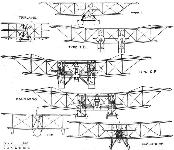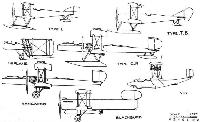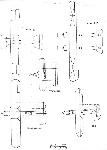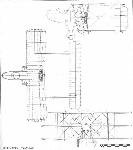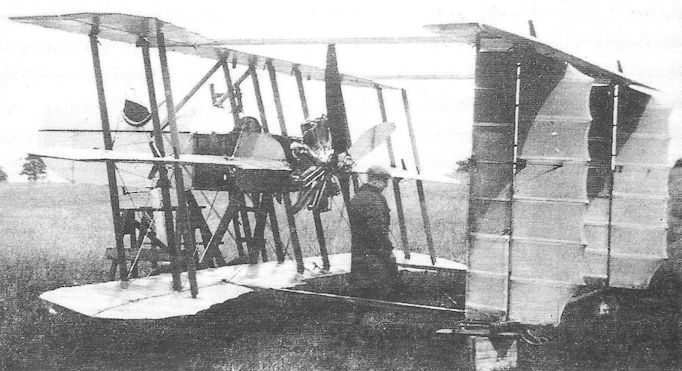
Описание
Страна: Великобритания
Год: 1916
Единственный экземпляр
Fighter
Варианты
- A.D. - Scout (Sparrow) - 1915 - Великобритания
- Blackburn - Triplane - 1916 - Великобритания
- A.Jackson Blackburn Aircraft since 1909 (Putnam)
- P.Lewis The British Fighter since 1912 (Putnam)
- F.Mason The British Fighter since 1912 (Putnam)
- W.Green, G.Swanborough The Complete Book of Fighters
- J.Bruce British Aeroplanes 1914-1918 (Putnam)
- H.King Armament of British Aircraft (Putnam)
- Журнал Flight
-
F.Mason - The British Fighter since 1912 /Putnam/
Designed by Harris Booth, the Blackburn Triplane carried a Davis two-pounder recoilless gun.
The Blackburn Triplane as first constructed with 110 hp Clerget rotary engine driving a four-bladed airscrew -
J.Bruce - British Aeroplanes 1914-1918 /Putnam/
The Blackburn triplane scout. 100 h.p. Gnome Monosoupape
-
P.Lewis - The British Fighter since 1912 /Putnam/
Blackburn Triplane fitted with 100 h.p. Monosoupape Gnome.
-
A.Jackson - Blackburn Aircraft since 1909 /Putnam/
The Blackburn Triplane with 100 hp Monosoupape and two-bladed airscrew.
-
Журнал - Flight за 1919 г.
Front elevations of the Blackburn machines
Другие самолёты на фотографии: Blackburn Blackburd - Великобритания - 1918Blackburn GP - Великобритания - 1916Blackburn Kangaroo / R.T.1 - Великобритания - 1917Blackburn N.1B - Великобритания - 1918Blackburn TB - Великобритания - 1915Blackburn Type L - Великобритания - 1914
-
Журнал - Flight за 1919 г.
Side elevations of the Blackburn machines
Другие самолёты на фотографии: Blackburn Blackburd - Великобритания - 1918Blackburn GP - Великобритания - 1916Blackburn Kangaroo / R.T.1 - Великобритания - 1917Blackburn N.1B - Великобритания - 1918Blackburn TB - Великобритания - 1915Blackburn Type L - Великобритания - 1914
-
Журнал - Flight за 1919 г.
Plan views of Blackburn machines
Другие самолёты на фотографии: Blackburn Blackburd - Великобритания - 1918Blackburn N.1B - Великобритания - 1918Blackburn TB - Великобритания - 1915Blackburn Type L - Великобритания - 1914
-
W.Green, G.Swanborough - The Complete Book of Fighters
Blackburn's extraordinary Triplane fighter of 1917.
-
A.Jackson - Blackburn Aircraft since 1909 /Putnam/
Blackburn Triplane
-
F.Mason - The British Fighter since 1912 /Putnam/
Blackburn Triplane
A.Jackson Blackburn Aircraft since 1909 (Putnam)
Blackburn Triplane
While the batch of T.B. seaplanes was going through the Blackburn works, the firm was also engaged in the construction under contract of two examples of another anti-Zeppelin fighter, the A.D. Scout (later known as the Sparrow), designed by Harris Booth of the Air Department of the Admiralty. This aircraft was a heavily-staggered, single-bay biplane of extremely unorthodox appearance, built to meet an Admiralty requirement for a fighter built from commercially obtainable materials and which could be armed with the Davis two-pounder quick-fire recoilless gun. This lay in the bottom of a short, single-seat nacelle, the top longerons of which were bolted directly to the main spars of the upper wing. With the 100 hp Gnome Monosoupape rotary driving a 9-ft pusher airscrew behind his back, the pilot had a superlative view in nearly every direction.
The aircraft's extraordinary appearance stemmed from the fact that the abnormally large mainplane gap was below instead of above the nacelle, and because the twin fins and rudders, no less than 11 ft apart, were mounted on two pairs of parallel outriggers and supported a vast tailplane of 21-ft span. A suitably bizarre undercarriage reversed the usual pattern, the three points of contact with terra firma being widely spaced skids under the fins and a pair of small wheels mounted close together centrally under the lower mainplane. In this respect it was similar to the Armstrong Whitworth F.K.12 triplane and the projected Bristol F.3A escort and anti-Zeppelin fighters, for it seems that Harris Booth believed in the 'pogo stick' type of landing gear as a means of simplifying cross-wind landings at night.
Four prototype aircraft only were ordered, 1452 and 1453 from Hewlett and Blondeau Ltd of Leagrave, Beds., and two others, 1536 and 1537, from Blackburns. They were all delivered to RNAS Chingford, but being considerably above their estimated all-up weight and difficult to handle in the air, were scrapped.
In 1916 Harris Booth left the Air Department of the Admiralty to join the Blackburn Aeroplane and Motor Co Ltd for whom he immediately designed what can only be regarded as a modified version of his A.D. Scout. To impart the high rate of roll needed by a slow machine taking evasive action round a target Zeppelin, the span was reduced from 33 ft 5 in to 24 ft but the lost wing area was regained by adopting a triplane configuration. It was then fitted with six inversely-tapered ailerons, those on the centre mainplane being cable-controlled from the cockpit and operating those above and below through link struts. The aircraft inherited the A.D. Scout's ugly nacelle and heavy stagger as well as the four parallel tail booms and outsize tailplane of no less than 18 ft 10 in span. The rudders were more enormous than ever so that altogether the Triplane was one of the most extraordinary looking aircraft ever built.
The two-wheel arrangement of the A.D. Scout was replaced by a bungee-sprung, V-type, cross-axle undercarriage of moderate track, but the bottom wing was so close to the ground that substantial wing tip skids were also necessary. In other respects the Triplane was structurally similar to its predecessor and had a wire-braced, fabric-covered wooden airframe which used metal fittings of commercial mild steel. Wing, tailplane and rudder trailing edges were formed from stout wire which gave under the tautening effect of the dope to form a scalloped shape between the ribs.
Only one prototype Triplane, N502, was built, and although contemporary photographs clearly show the gun port in the nose of the nacelle, it is doubtful if the Davis gun was ever fitted. The aircraft was erected in the Soldiers' Field at Roundhay Park, Leeds, where initial engine runs were made before despatch to Eastchurch at the end of 1916. The aircraft flew first with a 110 hp Clerget driving an 8ft-diameter four-bladed airscrew and later with a 100 hp Gnome and two-bladed airscrew. Admiralty acceptance took place at Eastchurch on 20 February 1917, but the Blackburn Triplane proved no more successful than the A.D. Scout and was struck off charge as unsatisfactory one month later on 19 March. Its end, like that of many another undeveloped pusher aircraft, was no doubt hastened by the invention of interruptor gear which enabled machine-guns to fire through the airscrew disc on tractor machines.
SPECIFICATION AND DATA
Manufacturers: The Blackburn Aeroplane and Motor Co Ltd, Olympia Works, Roundhay Road, Leeds, Yorks.
Power Plants:
(A.D. Scout) One 100 hp Gnome Monosoupape
(Triplane)
One 110 hp Clerget
One 100 hp Gnome Monosoupape
Dimensions:
(A.D. Scout)
Span 33 ft 5 in Length 22 ft 9 in
Height 10 ft 3 in
(Triplane)
Span 24 ft 0 in Length 21 ft 5 ft in
Height 8 ft 6 in Wing area 221 sq ft
Weights: (Triplane, Gnome) Tare weight 1,011 lb All-up weight 1,500 lb
Performance: No confirmed details
Production:
(A.D. Scout) Four aircraft only, 1452 and 1453 by Hewlett and Blondeau Ltd; 1536 and 1537 by Blackburn, to Contract 38552 15
(Triplane) One aircraft only, N502, to Contract CP. 120730 16
Описание:






